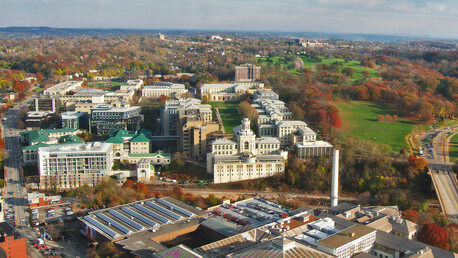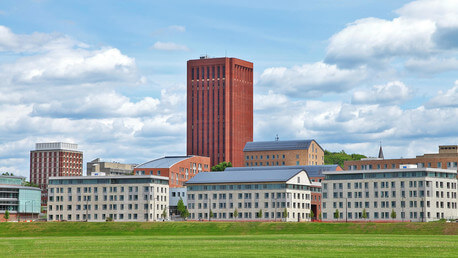Tuition, Cost & Aid
Affordability and Cost
Average Net Price Average net price for full-time, first-time degree/certificate-seeking undergraduates paying the in-state or in-district tuition rate who were awarded grant or scholarship aid from federal, state or local governments, or the institution. Other sources of grant aid are excluded. Aid awarded anytime during the full aid year is included.
Average net price is generated by subtracting the average amount of federal, state or local government, or institutional grant and scholarship aid from the total cost of attendance. Total cost of attendance is the sum of published tuition and required fees (lower of in-district or in-state), books and supplies and the weighted average room and board and other expenses.
Average net price is generated by subtracting the average amount of federal, state or local government, or institutional grant and scholarship aid from the total cost of attendance. Total cost of attendance is the sum of published tuition and required fees (lower of in-district or in-state), books and supplies and the weighted average room and board and other expenses.
$45,834
Average Net Price By Family Income
Tuition
| In-State Tuition In-state tuition is the tuition charged by institutions to those students who meet the state's or institution's residency requirements. In-district tuition is the tuition charged by the institution to those students residing in the locality in which they attend school and may be a lower rate than in-state tuition if offered by the institution. | $58,870 |
| Out-of-State Tuition Out-of-state tuition is the tuition charged by institutions to those students who do not meet the state's or institution's residency requirements. Out-of-district tuition is the tuition charged by the institution to those students not residing in the locality in which they attend school. | $58,870 |
Additional Costs
Room and Board The weighted average for room and board and other expenses is generated as follows:
| $18,072 |
| Books and Supplies | $1,200 |
| Tuition Payment Plan | Yes |
Financial Aid: visit page
Financial Aid Email: finaid@wpi.edu
Aid & Grants
0
100
74%
Need Met
Students Receiving Gift Aid Percent of undergraduate students awarded federal gift aid. Federal gift aid includes any grant or scholarship aid awarded, from the federal government, a state or local government, the institution, and other sources known by the institution. Students Receiving Grants Percent of undergraduate students awarded grant aid. Grant aid includes any grant or scholarship aid awarded, from the federal government, a state or local government, the institution, and other sources known by the institution. Students receiving state aid Students receiving federal aid
10%
Average Aid Per Year
$27,059
10%
Average Federal Grant Aid Per Year
$6,734
Average Institution Grant Aid Per Year
$26,262
4%
Average State Grant Aid Per Year
$2,021
10%
Average Federal Grant Aid Per Year
$6,734
Average Grant & Scholarship By Family Income
Total Needs Based Scholarships/Grants Total amount of grant or scholarship aid awarded to all undergraduates from the federal government, state/local government, the institution, and other sources known to the institution.
$82,923,560
Total Non-Need-Based Scholarships/Grants
$61,043,052
Student Loans
Students Borrowing Loans Loans to students - Any monies that must be repaid to the lending institution for which the student is the designated borrower. Includes all Title IV subsidized and unsubsidized loans and all institutionally- and privately-sponsored loans. Does not include PLUS and other loans made directly to parents.
55%
Average Loan Amount Per Year
$14,168
Students receiving federal loans
53%
Average Federal Loans Per Year
$5,328
Average Other Loans Per Year
$15,466
Average Debt at Graduation The median federal debt of undergraduate borrowers who graduated. This figure includes only federal loans; it excludes private student loans and Parent PLUS loans.
$26,991
Loan Default Rate
3%
US National: 7%
Median Monthly Loan Payment The median monthly loan payment for student borrowers who completed, if it were repaid over 10 years at a 5.05% interest rate.
$258
What Students Are Saying
A WPI degree makes it easier to get a job upon graduation. The projects teach you to solve real problems so you can make an impact on your field and do well right out of college. The campus is beautiful and the school offers everything you could need - academics, athletics, atmosphere, and experiences to help you succeed.
Alana from Taunton, MA
WPI definitely gives you a bang for the buck. Although it is relatively expensive, there are plenty of on campus jobs available to help you through. In addition to this, what you are paying for is truly exceptional. The accessability of professors, TA (teaching assistants) and PLAs (peer learning assistants) is amazing. They not only go above and beyond the minimum requirement for office hours, but they will often meet you outside of their office, to answer questions you might have, or perhaps even just to talk about potential future jobs.
WPI is also part of the Worcester Consortium, which is a collection of the 13 colleges in Worcester. By this connection, WPI students can take classes at any of the other schools in the consortium, completely free of charge and the credits are transferrable to WPI.
WPI also hold three job fairs a year. One in the fall, one in the spring and another for the life sciences majors. These career fairs are for WPI students ONLY, and the waitlist for companies trying to get a spot in the career fair is just as competitive as the students trying to get jobs.
Another great thing about WPI is that the lab equipment in all the labs is completely gutted out and redone every 3-4 years so that students are constantly using only the most up to date equipment. This is a huge selling point too when applying for jobs because students to not need to be trained in the new equipment because it's what they have been using already at WPI.
Post graduation, WPI have above a 90% placement rate into either the work force or competitive graduate programs. This is a very high number to look at. It has to do with the way students are bred for success at WPI, and the dedication the career development center puts into helping it's students acheive their goals.
WPI is also part of the Worcester Consortium, which is a collection of the 13 colleges in Worcester. By this connection, WPI students can take classes at any of the other schools in the consortium, completely free of charge and the credits are transferrable to WPI.
WPI also hold three job fairs a year. One in the fall, one in the spring and another for the life sciences majors. These career fairs are for WPI students ONLY, and the waitlist for companies trying to get a spot in the career fair is just as competitive as the students trying to get jobs.
Another great thing about WPI is that the lab equipment in all the labs is completely gutted out and redone every 3-4 years so that students are constantly using only the most up to date equipment. This is a huge selling point too when applying for jobs because students to not need to be trained in the new equipment because it's what they have been using already at WPI.
Post graduation, WPI have above a 90% placement rate into either the work force or competitive graduate programs. This is a very high number to look at. It has to do with the way students are bred for success at WPI, and the dedication the career development center puts into helping it's students acheive their goals.
Student from RI
i mean, i haven't graduated yet, but everyone keeps telling me i'm going to get an awesome job after graduation which is extremely reassuring. also, if you look up best return on college investment, i guarantee that wpi will come up. so yes, it is extremely expensive, but hopefully i can dig myself out of debt pretty quickly.
caroline from norwell, ma
I don't have personal experience of what happens after graduation, but my older friends tell me that the experience they had at WPI greatly helped them land a job over most of their high school friends. Their resume was beefed up thanks to IQP (Interactive Qualifying Project) and MQP (Major Qualifying Project), both of with you need in order to graduate. The IQP and MQP are projects you usually do in your junior and senior year respectively where you team up with other students to try and solve local or world problems. Both projects can be taken abroad.
Sonya from Nashua, NH
as a private engineering university, wpi is fairly expensive. however, you are going to gain a great degree, and even better understanding, experience, and practice. wpi loves to get jobs for its students!
Tori from Jefferson Hills, PA
The college has a great reputation, the average starting salary is around 60,000 a year.
Kyle from Norton, MA
I am accepted and received some scholarship money. The cost is still overwhelming though. It is the only thing that I don't like about this school. Then again you also have to consider that it is a private engineering school and that they are 4th in the nation for average starting salary out of undergraduate. It may pay it self back if you work hard.
Morgan from Park City, UT
Unless you've got good scholarships, the tuition is definitely crazy. If you know that this school has what you want, though, it's worth it.
Corey from Palisade, CO
Most of the students at WPI will have a job or go to grad school after getting their undergraduate degree. Many of the students will make around 50,000 or more at their first job as entry-level. That's not bad. While WPI is more expensive, it's a pretty solid bet for your future.
DeWitt, NY












